埃索美拉唑镁欧洲药典质量标准色谱图
埃索美拉唑镁肠溶胶囊含量测定研究

埃索美拉唑镁肠溶胶囊含量测定研究许剑峰;陈涛【摘要】目的:建立胃食管反流性疾病(GERD)药物埃索美拉唑镁肠溶胶囊活性成分埃索美拉唑镁的含量测定方法.方法:拟采用HPLC法.色谱柱C8键合反相柱,Phenomenex(150×4.6mm,5μm);流动相系统为等度洗脱:乙腈:磷酸盐缓冲溶液(7∶13);检测器为UV检测器,波长280nm;流速为1.0ml/min,进样量为20μl,柱温为30℃.结果:该药活性成分埃索美拉唑镁(以奥美拉唑RS计)进样量在0.80576μg~4.83456μg范围内与峰面积呈良好的线性关系A=15.191C+22.733 (r=0.9997),高中低三个浓度9个样平均加样回收率为100.11%,RSD为0.59%;结论:HPLC法测定埃索美拉唑镁含量准确度高、重复性好,可以作为埃索美拉唑镁肠溶胶囊含量测定方法.【期刊名称】《黑龙江科技信息》【年(卷),期】2016(000)017【总页数】1页(P34)【关键词】埃索美拉唑镁;HPLC法;含量测定【作者】许剑峰;陈涛【作者单位】哈药集团三精制药有限公司,黑龙江哈尔滨150000;哈药集团三精制药有限公司,黑龙江哈尔滨150000【正文语种】中文埃索美拉唑镁为奥美拉唑的左旋异构体,临床上用于胃食管反流性疾病(GERD)-糜烂性反流性食管炎的治疗。
已经治愈的食管炎患者防止复发的长期维持治疗。
胃食管反流性疾病(GERD)的症状控制。
与适当的抗菌疗法联合用药根除幽门螺杆菌,并且-愈合与幽门螺杆感染相关的十二指肠溃疡-防止与幽门螺杆菌相关的消化性溃疡复发。
相比奥美拉唑,副作用更少,效果更佳,因此,该类药物临床应用中,埃索美拉唑镁的市场份额不断扩大。
本文参考相关文献,及国外药典涉及原料药及制剂标准,并优化改进,建立了埃索美拉唑镁稳定可靠的定量控制方法。
Agilent 1260型HPLC色谱仪,电子分析天平(梅特勒-托利多XS205型)。
[宝典]欧洲药典附录3.1.3.
![[宝典]欧洲药典附录3.1.3.](https://img.taocdn.com/s3/m/f3357cec760bf78a6529647d27284b73f2423679.png)
3.1.3. 聚烯烃定义聚烯烃是通过乙烯或丙烯的聚合而成,或是通过这些不超过25%的高同系物的物质或羧酸或酯的共聚作用获得。
某些材料可能是聚烯烃的混合物。
成品添加一定数量的添加剂到聚合物中是为了优化它们的化学性质,物理性质和机械性能,为了使它们适用于预定用途。
所有的这些添加剂都是选自附件列表,并指出了每一种产品中的最大允许含量。
产品中最多包含有三种抗氧化剂,一种或几种润滑剂或抗粘连剂以及当材料必须提供光照保护时,还要添加二氧化钛作为遮光剂。
–二叔丁基对甲酚(增塑剂07):限量:0.125%–四钛季戊四醇松香酸酯[3-(3,5-二叔丁基-4-羟苯基)丙酸酯](增塑剂09):限量:0.3%–1,3,5-三羟甲基氨基甲烷(3,5-二叔丁基-4-邻羟苄基 )- 三嗪-2,4,6(1H,3H,5H)-三酮, (增塑剂 13): 限量: 0.3%–二乙烯[3,3-二[3-(1,1-dimethylethyl)-4-羟苯基]丁酸甲酯] (增塑剂08):限量:0.3%–二(十八烷基)二硫化物(增塑剂15)限量:0.3%4,4′,4″-(2,4,6-三甲基苯-1,3,5-triyltrismethylene)–三羟甲基氨基甲烷[2,6-二(1,1-dimethylethyl)苯酚](增塑剂10)限量:0.3%2,2′-二(octadecyloxy)-5,5′-spirobi[1,3,2-dioxaphosphinane](增塑剂 14): 限量:0.3 %;–didodecyl 3,3′-硫代二丙酸(增塑剂16): 限量: 0.3 %;–dioctadecyl3,3′-硫代二丙酸(增塑剂 17): 限量:0.3 %;–三羟甲基氨基甲烷[2,4-二(1,1-dimethylethyl)苯基] 亚磷酸盐 (增塑剂 12): 限量:0.3 %;–增塑剂 18: 限量: 0.1%;–琥珀酸二甲酯和 (4-hydroxy-2,2,6,6-tetramethylpiperidin-1-yl)乙醇的共聚物 (增塑剂 22): 限量:0.3%上面列出的抗氧化添加剂总含量不超过0.3%。
质量标准奥美拉唑

AS-NAI 质量标准
检查项目方法标准规定
性状目测
本品应为白色或类白色的冻干块状物或
粉末
鉴别一般鉴别试
验
本品显钠盐的鉴别反应(中国药典2010
年版二部附录Ⅲ)
HPLC
在对映体纯度测定项下记录的高效液相
色谱图中,供试品溶液主峰的保留时间
应与对照品溶液主峰的保留时间一致。
HPLC
在含量测定项下记录的高效液相色谱图
中,供试品溶液主峰的保留时间应与对
照品溶液主峰的保留时间一致。
溶液的颜色与澄清度溶液颜色检
查法
澄清度检查
法
取本品1瓶,加水1ml使溶解,溶液
应澄清无色,如显浑浊,与1号浊度标准
液(中国药典2010版二部附录IX B)比
较,不得更浓;如显色,与黄色1号标准
比色液(中国药典2010版二部附录IX A)
比较,不得更深。
碱度碱度检查法
取本品1瓶,加水1ml溶解后,依
法测定(中国药典2010版二部附录VI
H),pH值应为10.0~11.5
水分水分测定法
取本品适量,以无水甲醇为溶剂,照
水分测定法(中国药典2010年版二部附
录Ⅷ M第一法)测定,含水分不得过
0.5%。
有关物质HPLC 按面积归一化法计算,杂质C(碸)的量不得过0.2%、杂质A(咪唑), 杂质B (氮氧化物)和杂质D(硫醚)的量均不得过0.1%,其他单个杂质的量不得过0.1%,杂质总量不得过0.5%。
对映体纯度HPLC 纯度不低于99.5%
含量HPLC 含埃索美拉唑钠(C17H18N3NaO3S)应为标示量的90%~110%。
埃索美拉唑钠盐(原料药)标准 USP MC - Esomeprazole Sodium - 2012-07-23
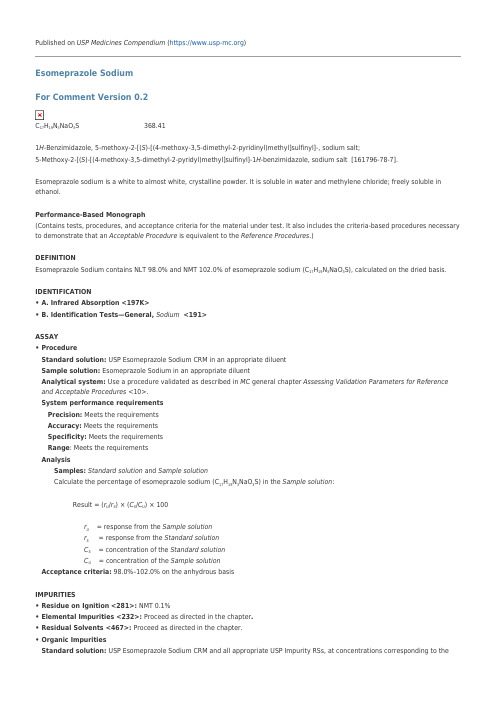
Acceptance criteria of the impurity, in an appropriate diluent Sample solution: Esomeprazole Sodium in an appropriate diluent Analytical system: Use a procedure validated as described in MC general chapter Assessing Validation Parameters for Reference and Acceptable Procedures <10>.
ASSAY • Procedure
Solution A: 10 mM ammonium acetate in water. Adjust with ammonium hydroxide solution to a pH of 7.0. Solution B: Methanol and acetonitrile (1:1) Mobile phase: See Table 1.
IMPURITIES • Residue on Ignition <281>: NMT 0.1% • Elemental Impurities <232>: Proceed as directed in the chapter. • Residual Solvents <467>: Proceed as directed in the chapter. • Organic Impurities
埃索美拉唑镁usp34

© 2010 USPC Official 5/1/11 - 7/31/11 USP Monographs: Esomeprazole ...
页码,Байду номын сангаас/7
prepared atomic absorption standard solution. [NOTE—Store the solution in a plastic bottle. ] Standard solution A: Transfer 10.0 mL of Standard stock solution to a 500-mL volumetric flask, add 50 mL of 1 N hydrochloric acid, and dilute with water to volume. Transfer 20.0 mL of this solution to a 200-mL volumetric flask, and dilute with water to volume. [NOTE —This solution contains 2 µg/mL of magnesium. ] Standard solution B: Combine 5.0 mL of Standard solution A and 4.0 mL of Lanthanum solution , and dilute with water to 100.0 mL (0.1 µg/mL). Standard solution C: Combine 10.0 mL of Standard solution A and 4.0 mL of Lanthanum solution , and dilute with water to 100.0 mL (0.2 µg/mL). Standard solution D: Combine 15.0 mL of Standard solution A and 4.0 mL of Lanthanum solution , and dilute with water to 100.0 mL (0.3 µg/mL). Standard solution E: Combine 20.0 mL of Standard solution A and 4.0 mL of Lanthanum solution , and dilute with water to 100.0 mL (0.4 µg/mL). Standard solution F: Combine 25.0 mL of Standard solution A and 4.0 mL of Lanthanum solution , and dilute with water to 100.0 mL (0.5 µg/mL). [NOTE— Concentrations of the Standard solutions and the Sample solution may be modified to fit the linear or working range of the instrument. When using instruments with a linear calibration graph, the number of Standard solutions can be reduced. ] Blank solution: Transfer 4.0 mL of Lanthanum solution to a 100-mL volumetric flask, and dilute with water to volume. Sample solution: Transfer 250 mg of Esomeprazole Magnesium to a 100-mL volumetric flask, add 20 mL of 1 N hydrochloric acid, swirl until dissolved, and dilute with water to volume. Allow to stand for 30 min. Transfer 10.0 mL of this solution to a 200-mL volumetric flask, and dilute with water to volume. Transfer 10.0 mL of the solution to another 100 -mL volumetric flask, add 4.0 mL of Lanthanum solution , and dilute with water to volume. Spectrometric conditions (See Spectrophotometry and Light-Scattering 851 .) Mode: Atomic absorption spectrophotometer Flame: Air–acetylene Analytical wavelength: 285.2 nm Analysis Samples: Standard solution B, Standard solution C, Standard solution D, Standard solution E , Standard solution F, Blank solution , and Sample solution Determine the concentration, C s , in µg/mL, of magnesium in the Sample solution using the calibration graph. Calculate the percentage of magnesium in the portion of Esomeprazole Magnesium taken:
埃索美拉唑杂质
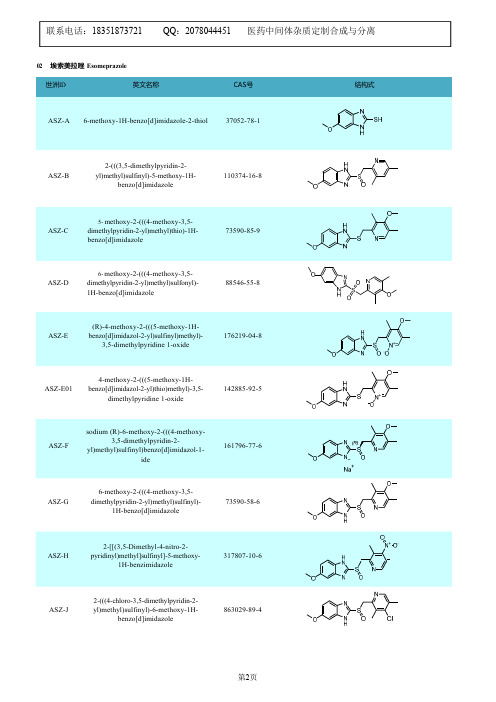
1227380-90-6
ASZ-H193
6-methoxy-2-(((4-methoxy-3,5dimethylpyridin-2-yl)methyl)sulfinyl)-1methyl-1H-benzo[d]imidazole AND 5methoxy-2-(((4-methoxy-3,5dimethylpyridin-2-yl)methyl)sulfinyl)-1methyl-1H-benzo[d]imidazole
73590-58-6
ASZ-H
2-[[(3,5-Dimethyl-4-nitro-2pyridinyl)methyl]sulfinyl]-5-methoxy1H-benzimidazole
317807-10-6
ASZ-J
2-(((4-chloro-3,5-dimethylpyridin-2yl)methyl)sulfinyl)-6-methoxy-1Hbenzo[d]imidazole
784143-42-6 89352-76-1
ASZ-H215/01
4sodium 2-(((3,5-dimethyl-4oxidopyridin-2-yl)methyl)sulfinyl)-5methoxybenzo[d]imidazol-1-ide
1803449-15-1 (free base: 301669-82-9)
863029-89-4
第2页
联系电话:18351873721
QQ:2078044451
医药中间体杂质定制合成与分离
ASZ-K
(((4-methoxy-3,5-dimethylpyridin-2yl)methyl)sulfinyl)-1Hbenzo[d]imidazole compound with 6- methoxy-1-((4-methoxy-3,5dimethylpyridin-2-yl)methyl)-2-(((4methoxy-3,5-dimethylpyridin-2yl)methyl)sulfinyl)-1Hbenzo[d]imidazole (1:1)
埃索美拉唑镁肠溶微丸的制备与质量控制

埃索美拉唑镁肠溶微丸的制备与质量控制摘要:目的:制备埃索美拉唑镁肠溶微丸,建立质量控制方案。
方法:应用流化床包衣法(底喷),成功制备出埃索美拉唑镁肠溶微丸,进行溶出度、耐酸力测定,评价埃索美拉唑镁肠溶微丸的质量。
结果:pH值6.8的人工肠液中,自制埃索美拉唑镁肠溶微丸的溶出度>86%,pH值1.2的氯化氢溶液中(模拟胃液环境),自制埃索美拉唑镁肠溶微丸的累积溶出度<2%。
结论:人工肠液中,自制埃索美拉唑镁肠溶微丸的溶出较完全,人工胃液中,自制埃索美拉唑镁肠溶微丸的耐酸力较好,该制备工艺可靠,药物质量理想,可推广。
关键词:埃索美拉唑镁肠溶微丸;制备工艺;质量控制埃索美拉唑镁主要应用于胃食管反流性疾病的临床治疗中,但容易被酸性物质所催化降解,为避免其被胃酸破坏、降低疗效,需要进行包衣处理,也就是制备埃索美拉唑镁肠溶微丸。
1.材料与方法1.1材料与仪器1)材料:埃索美拉唑镁三水合物、滑石粉、空白糖丸、羟丙基甲基纤维素(HPMC)、羟丙基纤维素(HPC)、柠檬酸三乙酯、乙腈。
2)仪器:小型流化床包衣机、磁力搅拌器、恒流泵、智能溶出仪、分析天平、高效液相色谱仪。
1.2埃索美拉唑镁肠溶微丸的制备工艺1)载药微丸的制备。
以3% HPMC水溶液为黏合剂,并加入埃索美拉唑镁,从而制备为混悬液。
在小型流化床包衣机中对空白糖丸进行加工,应用底喷工艺,将其制成载药丸心,工艺参数:雾化压力0.1兆帕至0.11兆帕、床温30±1摄氏度、平衡状态下的喷液流速每分钟1.5毫升。
载药丸心制备完成后,流化干燥30分钟。
2)隔离微丸的制备。
取处方量的HPC、滑石粉溶于水中,制备隔离包衣液,浓度为3.5%。
在小型流化床包衣机中应用底喷工艺进行包衣处理,工艺参数:雾化压力0.1兆帕、床温37摄氏度、喷液流速每分钟3.5毫升。
包衣完成后,流化干燥30分钟。
载药微丸包衣的目的是,由于埃索美拉唑镁在酸性环境下容易发生分解,因此需要将埃索美拉唑镁制备为肠溶剂,但使用的是弱酸性的肠溶包衣材料,所以应进行隔离包衣处理,避免肠溶材料与埃索美拉唑镁发生化学反应[1]。
埃索美拉唑镁标准-EP7.0

CHARACTERS Appearance: white or slightly coloured powder, slightly hygroscopic. Solubility : slightly soluble in water, soluble in methanol, practically insoluble in heptane.
ห้องสมุดไป่ตู้
TESTS
A. pXe=ntNa-nCoHl,3: 1-[(2-chlorophenyl)(methylimino)methyl]cycloC. X = O : (2-chlorophenyl)(1-hydroxycyclopentyl)methanone,
B. (2RS)-2-(2-chlorophenyl)-2-hydroxycyclohexanone,
identification CRS and the chromatogram obtained with reference solution (b) to identify the peak due to impurity E ; — use the chromatogram obtained with reference solution (a) to identify the peak due to impurity D. Relative retention with reference to esomeprazole (retention time = about 9 min) : impurity E = about 0.6 ; impurity D = about 0.8. System suitability : reference solution (a) : — resolution : minimum 3.0 between the peaks due to impurity D and omeprazole. If necessary, adjust the pH of the aqueous part of the mobile phase or its proportion of acetonitrile ; an increase in the pH will improve the resolution. Limits : — impurity D : maximum 0.2 per cent ; — impurity E : maximum 0.1 per cent; — unspecified impurities : for each impurity, maximum 0.10 per cent ; — total : maximum 0.5 per cent ; — disregard limit : 0.5 times the area of the principal peak in the chromatogram obtained with reference solution (c) (0.05 per cent).
埃索美拉唑镁三水合物(EP8.0译文)

埃索美拉唑镁三水合物C34H36MgN6O6S2,3H2O M r 767.2[217087-09-7]化学名:镁双[5-甲氧基-2-[(S)-[(4-甲氧基-3,5-二甲基吡啶-2-基)甲基]亚磺酰基]-1H-苯并咪唑-1-基]三水合物。
含量:98.0-102.0%(无水物)性状外观:白色或类白色粉末,微有引湿性。
溶解性:微溶于水,易溶于甲醇,在庚烷中几乎不溶。
鉴别完成其中一组试验:A,B,C;A,B,E;B,C,D;B,D,E。
A.比旋光度(2.2.7):- 155。
~ - 137。
溶解0.250g到甲醇中,并用相同的溶剂稀释至25.0 mLB.红外吸收分光光度法(2.2.24)。
比较:埃索美拉唑镁三水合物对照品。
C.原子吸收光谱法(2.2.23)镁检查项下,测试溶液在285.2nm处显示最大吸收D.对映体纯度(见检查项下)。
E:根据硫酸盐灰分的测试程序(2.4.14),点燃约0.5g被检查物质。
残留物用10mL水溶解,该溶液2mL应显示镁的反应(2.3.1)。
检查吸光度 (2.2.25):≤0.20 (440 nm)用甲醇溶解0.500g,并稀释至25.0 mL,通过膜过滤器过滤该溶液(标称孔径0.45微米)。
有关物质液相色谱法(2.2.29)。
使用标准程序。
使用新鲜配制的溶液。
供试品溶液用流动相溶解3.5mg被测物质,并稀释至25.0ml。
对照溶液(a)。
用流动相溶解1mg奥美拉唑对照品和1mg奥美拉唑杂质D对照品,并稀释至10.0ml。
对照溶液(b)用流动相溶解3mg奥美拉唑峰识别用对照品(含杂质E)并稀释至20.0ml。
对照溶液(c)用流动相稀释1.0ml供试品溶液至100.0ml,再用流动相稀释此溶液1.0ml 至10.0ml。
色谱柱:规格: 4.6*125固定相:辛烷基硅烷键合硅胶(C8 5μm)流动相:混合27体积的乙腈和73倍体积的磷酸氢二钠溶液(1.4g/ L用磷酸调节pH至7.6)流速: 1 mL/min.紫外分光光度检测器: 280 nm.进样: 40 μL.运行时间:埃索美拉唑保留时间的5倍。
埃索美拉唑镁的合成工艺精品资料
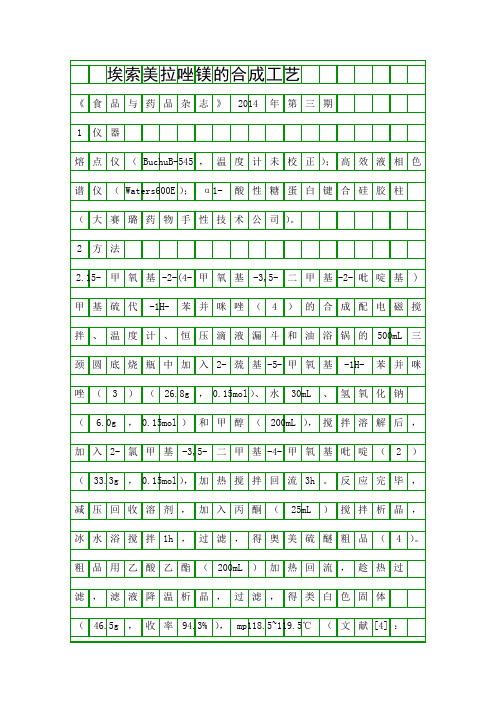
制备奥美硫醚时,采用不对称氧化法,产品收率高,手性纯度好,避免了采用拆分法中拆分试剂价格昂贵、物料损失大等缺点,氧化反应条件温和,方便可控。以水为溶剂制备埃索美拉唑镁,绿色环保,产品收率高。通过精制,滤除了产品中残存的无机镁盐,解决了产品镁离子含量超标和溶解度不合格等问题,产品纯度为99.88%,手性纯度ee值达到100%,总收率67.8%,各项检测指标达到药品注册要求。本工艺条件温和,操作简便,生产成本低,绿色环保,适用于工业化生产。
2.3埃索美拉唑镁粗品(6)的制备埃索美拉唑钾盐粗品33g,溶于60mL水,缓慢滴加33mL(3.16mol/L)硫酸镁水溶液,滴毕,继续搅拌反应1h,过滤,滤饼用40mL水洗涤,40℃真空干燥得埃索美拉唑镁粗品(6)(30.3g,收率91.8%),HPLC检测纯度99.13%,HPLC手性柱法检测对映体纯度ee值100%(文献[8]:收率83.3%)。
2.2埃索美拉唑钾盐(5)的制备于250mL四口瓶中加入甲苯(185mL),化合物(4)(39.0g,0.12mol),D-(-)-酒石酸二乙酯(4.3mL,0.025mol),搅拌下加热至50℃,在此温度下反应20min;加入异丙醇钛(3.6mL,0.12mol),保温反应45min;冷却反应液至30℃,加入二异丙基乙基胺(3.1mL,0.018mol),滴加过氧化氢异丙苯[20.0g,含量87%(GC法),0.12mol],控制滴加速度以保持反应温度在28~32℃;滴毕继续反应2h。加入甲醇钾(12.3g,0.18mol)溶液(溶解于醇中),搅拌析晶;过滤,滤饼35℃真空干燥,得埃索美拉唑钾(5)(41.5g,收率91.4%),HPLC检测纯度97.52%,HPLC手性柱法检测对映体纯度ee值98.78%(文献[3]:收率74%)。
埃索美拉唑杂质分析
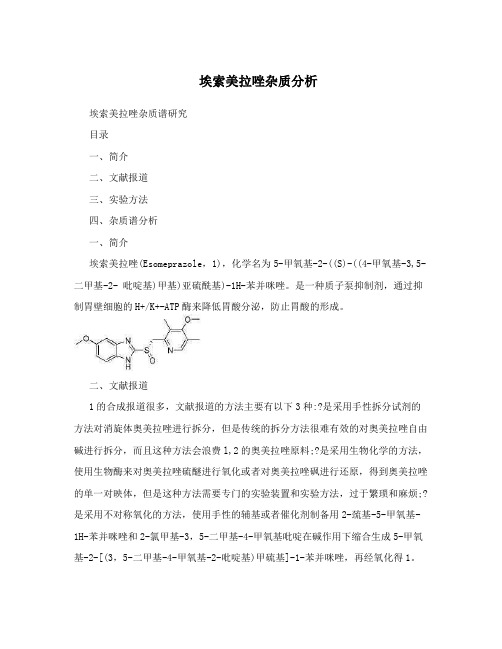
埃索美拉唑杂质分析埃索美拉唑杂质谱研究目录一、简介二、文献报道三、实验方法四、杂质谱分析一、简介埃索美拉唑(Esomeprazole,1),化学名为5-甲氧基-2-((S)-((4-甲氧基-3,5-二甲基-2- 吡啶基)甲基)亚硫酰基)-1H-苯并咪唑。
是一种质子泵抑制剂,通过抑制胃壁细胞的H+/K+-ATP酶来降低胃酸分泌,防止胃酸的形成。
二、文献报道1的合成报道很多,文献报道的方法主要有以下3种:?是采用手性拆分试剂的方法对消旋体奥美拉唑进行拆分,但是传统的拆分方法很难有效的对奥美拉唑自由碱进行拆分,而且这种方法会浪费l,2的奥美拉唑原料;?是采用生物化学的方法,使用生物酶来对奥美拉唑硫醚进行氧化或者对奥美拉唑砜进行还原,得到奥美拉唑的单一对映体,但是这种方法需要专门的实验装置和实验方法,过于繁琐和麻烦;?是采用不对称氧化的方法,使用手性的辅基或者催化剂制备用2-巯基-5-甲氧基-1H-苯并咪唑和2-氯甲基-3,5-二甲基-4-甲氧基吡啶在碱作用下缩合生成5-甲氧基-2-[(3,5-二甲基-4-甲氧基-2-吡啶基)甲硫基]-1-苯并咪唑,再经氧化得1。
运用不对称氧化技术合成埃索美拉唑更加符合绿色化学和原子经济性原则,工艺也已非常成熟。
关键中间体和所需的辅助原料价格都比较便宜而且极易获得。
其中间体硫醚的合成方法较多:傅建渭等(傅建渭,陶兴法,傅诏娟,王井明.中国医药工业杂志[J],2007,38(2):78)在硝化制得2,3,5-三甲基-4-硝基吡啶-N-氧化物后,不经甲氧基化反应,直接在乙酐中重排,再经盐酸水解得2-羟甲基-3,5-二甲基-4-硝基吡啶(4),4与氯化亚砜反应得2-氯甲基-3,5-二甲基-4-硝基吡啶盐酸盐(5),5和2-巯基-5-甲氧基苯并眯唑在甲醇钠参与下缩合成硫醚,同时4-硝基被甲氧基取代,得5-甲氧基-2-[(4-甲氧基-3,5-二甲基吡啶-2-基)甲硫基]-1-苯并咪唑(6)。
HPLC法测定注射用埃索美拉唑钠的含量

HPLC法测定注射用埃索美拉唑钠的含量杨林;戴芸【摘要】目的:建立反相高效液相色谱法测定注射用埃索美拉唑钠含量的方法.方法:采用Diamonsil C18色谱柱(4.6mm×150mm,5μm),流动相为20mM K2HPO4缓冲液(pH值6.86)-甲醇(35:65,V/V),流速为1 mL· min-1,检测波长为302nm.结果:埃索美拉唑钠的线性范围为50~200μg·mL-1,r=0.9997,平均回收率99.2%,RSD=0.6%(n=9).结论:该方法快速、简便、准确,适用于注射用埃索美拉唑钠的含量测定.【期刊名称】《化学工程师》【年(卷),期】2016(030)001【总页数】3页(P31-32,4)【关键词】HPLC;埃索美拉唑钠;注射;含量测定【作者】杨林;戴芸【作者单位】黄石市中心医院(湖北理工学院附属医院)药学部,湖北黄石435000;肾脏疾病发生与干预湖北省重点实验室,湖北黄石435000;黄石市中心医院(湖北理工学院附属医院)药学部,湖北黄石435000;肾脏疾病发生与干预湖北省重点实验室,湖北黄石435000【正文语种】中文【中图分类】R917质子泵抑制剂(proton pump inhibitor,PPI)在临床上主要应用于治疗酸相关性疾病,主要包括溃疡病、胃食管反流病(GERD)和胃泌素瘤的治疗[1]。
第一个PPI——奥美拉唑(omeprazole,OPZ)于1988年上市[2,3]。
OPZ是两种光学异构体的消旋混合物(S-奥美拉唑和R-奥美拉唑),其中S-奥美拉唑被称为埃索美拉唑(esomeprazole),是第一个发展为异构体的PPI,主要用于治疗GERD、幽门螺杆菌(HP)阳性的消化性溃疡及与胃酸有关的消化系统紊乱性疾病,其血药浓度和生物利用度比奥美拉唑或R-奥美拉唑,且抑酸作用更强[4,5]。
本文建立了测定注射用埃索美拉唑钠含量的高效液相色谱法,方法专属性好,灵敏度高,快速准确。
LC-MS-MS法测定犬体内血浆中埃索美拉唑药物浓度
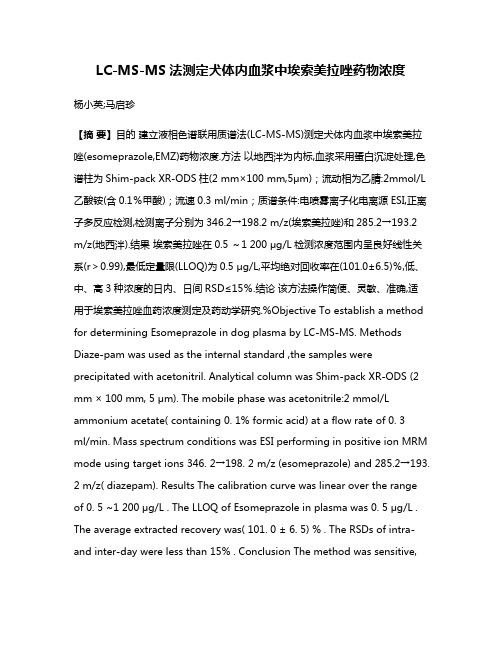
LC-MS-MS法测定犬体内血浆中埃索美拉唑药物浓度杨小英;马启珍【摘要】目的建立液相色谱联用质谱法(LC-MS-MS)测定犬体内血浆中埃索美拉唑(esomeprazole,EMZ)药物浓度.方法以地西泮为内标,血浆采用蛋白沉淀处理,色谱柱为Shim-pack XR-ODS柱(2 mm×100 mm,5μm);流动相为乙腈:2mmol/L 乙酸铵(含0.1%甲酸);流速0.3 ml/min;质谱条件:电喷雾离子化电离源ESI,正离子多反应检测,检测离子分别为346.2→198.2 m/z(埃索美拉唑)和285.2→193.2 m/z(地西泮).结果埃索美拉唑在0.5 ~1 200 μg/L检测浓度范围内呈良好线性关系(r>0.99),最低定量限(LLOQ)为0.5 μg/L,平均绝对回收率在(101.0±6.5)%,低、中、高3种浓度的日内、日间RSD≤15%.结论该方法操作简便、灵敏、准确,适用于埃索美拉唑血药浓度测定及药动学研究.%Objective To establish a method for determining Esomeprazole in dog plasma by LC-MS-MS. Methods Diaze-pam was used as the internal standard ,the samples were precipitated with acetonitril. Analytical column was Shim-pack XR-ODS (2 mm × 100 mm, 5 μm). The mobile phase was acetonitrile:2 mmol/L ammonium acetate( containing 0. 1% formic acid) at a flow rate of 0. 3ml/min. Mass spectrum conditions was ESI performing in positive ion MRM mode using target ions 346. 2→198. 2 m/z (esomeprazole) and 285.2→193.2 m/z( diazepam). Results The calibration curve was linear over the range of 0. 5 ~1 200 μg/L . The LLOQ of Esomeprazole in plasma was 0. 5 μg/L . The average extracted recovery was( 101. 0 ± 6. 5) % . The RSDs of intra- and inter-day were less than 15% . Conclusion The method was sensitive,simple and accurate to determinate Esomeprazole plasma concentration and suitable to the pharmacokinetics study.【期刊名称】《药学实践杂志》【年(卷),期】2013(031)001【总页数】3页(P61-63)【关键词】埃索美拉唑;液相色谱联用质谱;血药浓度【作者】杨小英;马启珍【作者单位】宁夏医科大学总医院药剂科,宁夏银川750004;宁夏医科大学总医院临床药理研究室,宁夏银川750004;宁夏医科大学总医院药剂科,宁夏银川750004【正文语种】中文【中图分类】R927埃索美拉唑(esomeprazole,EMZ)为奥美拉唑的S-异构体,其口服肝代谢率较低,血药浓度和生物利用度比奥美拉唑高,且抑酸作用更强[1]。
埃索美拉唑镁肠溶胶囊USP质量标准Esomeprazole Magnesium Delayed-Release Capsules
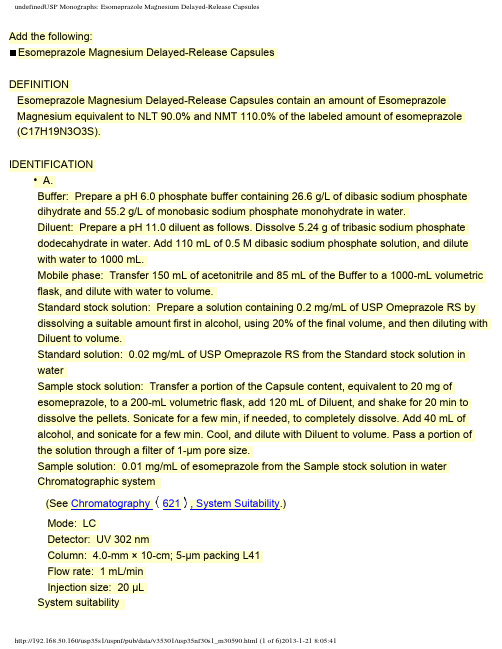
Add the following:Esomeprazole Magnesium Delayed-Release CapsulesDEFINITIONEsomeprazole Magnesium Delayed-Release Capsules contain an amount of Esomeprazole Magnesium equivalent to NLT 90.0% and NMT 110.0% of the labeled amount of esomeprazole(C17H19N3O3S).IDENTIFICATION• A.Buffer: Prepare a pH 6.0 phosphate buffer containing 26.6 g/L of dibasic sodium phosphatedihydrate and 55.2 g/L of monobasic sodium phosphate monohydrate in water.Diluent: Prepare a pH 11.0 diluent as follows. Dissolve 5.24 g of tribasic sodium phosphatedodecahydrate in water. Add 110 mL of 0.5 M dibasic sodium phosphate solution, and dilute with water to 1000 mL.Mobile phase: Transfer 150 mL of acetonitrile and 85 mL of the Buffer to a 1000-mL volumetric flask, and dilute with water to volume.Standard stock solution: Prepare a solution containing 0.2 mg/mL of USP Omeprazole RS by dissolving a suitable amount first in alcohol, using 20% of the final volume, and then diluting with Diluent to volume.Standard solution: 0.02 mg/mL of USP Omeprazole RS from the Standard stock solution inwaterSample stock solution: Transfer a portion of the Capsule content, equivalent to 20 mg ofesomeprazole, to a 200-mL volumetric flask, add 120 mL of Diluent, and shake for 20 min to dissolve the pellets. Sonicate for a few min, if needed, to completely dissolve. Add 40 mL ofalcohol, and sonicate for a few min. Cool, and dilute with Diluent to volume. Pass a portion of the solution through a filter of 1-µm pore size.Sample solution: 0.01 mg/mL of esomeprazole from the Sample stock solution in waterChromatographic systemChromatography 621, System SuitabilityMode: LCDetector: UV 302 nmColumn: 4.0-mm × 10-cm; 5-µm packing L41Flow rate: 1 mL/minInjection size: 20 µLSystem suitabilitySample: Standard solution[Note—The elution order is the R-enantiomer, followed by the esomeprazole peak, which is the S-enantiomer. ]Suitability requirementsResolution: NLT 1.0 between the enantiomer peaksAnalysisSamples: Standard solution and Sample solutionCalculate the ratio of the retention times of the esomeprazole peak in the Standard solutionand the Sample solution:Result = (tU/tS)tU== retention time of esomeprazole from the SamplesolutiontS== retention time of esomeprazole from the StandardsolutionAcceptance criteria: 0.98–1.02ASSAY• ProcedureBuffer: Prepare a pH 7.3 phosphate buffer by mixing 10.5 mL of 1.0 M monobasic sodiumphosphate buffer and 60 mL of 0.5 M dibasic sodium phosphate buffer, and diluting with water to 1000 mL.Diluent: Prepare as directed in Identification test A.Mobile phase: Mix 350 mL of acetonitrile and 500 mL of the Buffer. Dilute with water to 1000 mL.Standard solution: Transfer 10 mg of USP Omeprazole RS to a 250-mL volumetric flask, and dissolve in about 10 mL of methanol. Add 40 mL of Diluent, and dilute with water to volume. This solution contains 0.04 mg/mL of USP Omeprazole RS.Sample stock solution: Mix the contents of NLT 20 Capsules. Transfer a portion of the Capsule content, equivalent to 20 mg of esomeprazole, to a 100-mL volumetric flask, add 60 mL ofDiluent, and shake for 20 min to dissolve the pellets. Sonicate for a few min, if needed, tocompletely dissolve. Add 20 mL of alcohol, and sonicate for a few min. Cool, and dilute withDiluent to volume. Pass a portion of the solution through a filter of 1-µm pore size.Sample solution: 0.04 mg/mL of esomeprazole from the Sample stock solution in water. Store this solution protected from light.Chromatographic systemChromatography 621, System SuitabilityMode: LCDetector: UV 302 nmColumn: 4.6-mm × 15-cm; 5-µm packing L1Flow rate: 1 mL/minInjection size: 20 µLSystem suitabilitySample: Standard solutionSuitability requirementsRelative standard deviation: NMT 2.0%AnalysisSamples: Standard solution and Sample solutionCalculate the percentage of the labeled amount of esomeprazole (C17H19N3O3S) in theportion of the Capsules taken:Result = (rU/rS) × (CS/CU) × 100rU== peak response from the Sample solutionrS== peak response from the Standard solutionCS== concentration of USP Omeprazole RS in theStandard solution (mg/mL)CU== nominal concentration of esomeprazole in theSample solution (mg/mL)Acceptance criteria: 90.0%–110.0%PERFORMANCE TESTSDissolution 711Medium: 0.1 N hydrochloric acid; 300 mL. After 2 h, continue with a pH 6.8 phosphate buffer as follows. To the vessel, add 700 mL of 0.086 M dibasic sodium phosphate, and adjust with 2 N hydrochloric acid or 2 N sodium, if necessary, to a pH of 6.8 ± 0.05.Apparatus 2: 100 rpmTime: 30 min in a pH 6.8 phosphate bufferStandard solution: Prepare a solution containing 2 mg/mL of USP Omeprazole RS in alcohol.Dilute this solution with pH 6.8 phosphate buffer to obtain a solution containing (L/1000) mg/mL, where L is the label claim, in mg/Capsule. Immediately add 2.0 mL of 0.25 M sodium hydroxide to 10.0 mL of this solution, and mix. [Note—Do not allow the solution to stand before adding the sodium hydroxide solution. ]Sample solution: After 30 min in pH 6.8 phosphate buffer, pass a portion of the solution undertest through a suitable filter. Transfer 5.0 mL of the filtrate to a suitable glassware containing 1.0 mL of 0.25 M sodium hydroxide. Mix well. Protect from light.Buffer, Diluent, Mobile phase, System suitability, and Chromatographic system: Proceed asdirected in the Assay.AnalysisSamples: Standard solution and Sample solutionCalculate the percentage of esomeprazole (C17H19N3O3S) dissolved:Result = (rU/rS) × (CS/L) × V × 100rU== peak response from the Sample solutionrS== peak response from the Standard solutionCS== concentration of the Standard solution (mg/mL)L== label claim (mg/Capsule)V== volume of Medium, 1000 mLTolerances: NLT 75% (Q) of the labeled amount of esomeprazole (C17H19N3O3S) isdissolved.Uniformity of Dosage Units 905: Meet the requirementsIMPURITIES• Organic ImpuritiesBuffer: Prepare a pH 7.6 phosphate buffer by mixing 5.2 mL of 1.0 M monobasic sodiumphosphate buffer and 63 mL of 0.5 M dibasic sodium phosphate buffer, and diluting with water to 1000 mL.Solution A: Mix 100 mL of acetonitrile and 100 mL of the Buffer. Dilute with water to 1000 mL.Solution B: Mix 800 mL of acetonitrile and 10 mL of the Buffer. Dilute with water to 1000 mL.Table 1Time (min)Solution A(%)Solution B(%)01000108020300100311000451000Diluent: Prepare as directed in Identification test A.System suitability stock solution: 1 mg/mL each of USP Omeprazole RS and USP OmeprazoleRelated Compound A RS in methanolSystem suitability solution: 1 µg/mL each of USP Omeprazole RS and USP Omeprazole Related Compound A RS from System suitability stock solution, in a mixture of Diluent and water (1:4)Sample solution: Transfer a portion of the powdered pellets, from the Capsule content, equivalent to 80–90 mg of esomeprazole, to a 200-mL volumetric flask, add 20 mL of methanol, and shake for 30 s. Add 40 mL of Diluent, shake for 30 s by hand, and sonicate for a few min. Cool, and dilute with water to volume. Pass a portion of the solution through a filter of 0.45-µm pore size. [Note—The solution is stable for 3 h if stored protected from light. ] Chromatographic systemChromatography 621, System SuitabilityMode: LCDetector: UV 302 nmColumn: 4.6-mm × 10-cm; 3-µm packing L1Flow rate: 1 mL/minInjection size: 20 µLSystem suitabilitySample: System suitability solutionSuitability requirementsResolution: NLT 2.5 between omeprazole related compound A and omeprazoleAnalysisSample: Sample solutionCalculate the percentage of any individual impurity in the portion of the Capsules taken:Result = (rU/rT) × 100rU== peak response for each impurityrT== sum of all peak responsesTable 2NameRelativeRetentionTimeAcceptanceCriteria,NMT (%)Omeprazole sulfone a0.930.5 Omeprazole 1.00—Any other individual impurity—0.2Total impurities—2ADDITIONAL REQUIREMENTS• Packaging and Storage: Preserve in tight containers. Store at room temperature.USP Reference Standards11USP Omeprazole RSUSP Omeprazole Related Compound A RSOmeprazole sulfone; 5-methoxy-2-[[(4-methoxy-3,5-dimethyl-2-pyridinyl)methyl]sulfonyl]-1H-benzimidazole.C17H19N3O4S 361.421S (USP35)711。
RP-HPLC法测定埃索美拉唑镁肠溶微丸胶囊的溶出度

科技资讯2015 NO.33SCIENCE & TECHNOLOGY INFORMATION学 术 论 坛埃索美拉唑镁是阿斯利康制药有限公司的专利产品,是奥美拉唑的S-异构体、壁细胞中质子泵的的特异性抑制剂,也是质子泵抑制剂家族中第1个单一光学异构体,是目前治疗消化性溃疡病抑制胃酸分泌最为有效的药物。
其在抗消化性溃疡药物质子泵抑制剂中市场占有率较高,排名第2位,仅次于奥美拉唑。
埃索美拉唑镁在胃酸中不稳定,所以,专利产品中是以肠溶片制剂上市。
该项目组采用离心制粒包衣法制备埃索美拉唑镁肠溶微丸,并采用RP-HPLC法测定其溶出曲线,内容如下所示。
1 主要仪器与部分试剂Waters2695-2996型高效液相色谱仪。
埃索美拉唑镁肠溶微丸(自制,规格:40mg。
批号:20120901、20120902、20120903);埃索美拉唑镁对照品;乙腈、甲醇为色谱纯,其他试剂为分析纯。
2 方法与结果2.1 色谱条件及系统适应性试验色谱柱:KromasilC18(250mm×4.6mm,5μm);流动相:乙腈-磷酸二氢钠水溶液(取磷酸二氢钠15.6g,加蒸馏水水溶解并定容至2000mL容量瓶中并用磷酸调节pH至7.6)=45∶55;流速:1mL/min;检测波长:280nm;柱温:30℃;进样量:100μL。
在此实验下,理论板数按埃索美拉唑镁峰计应不低于2000,供试品中埃索美拉唑镁峰能达到基线分离。
色谱图见图1、图2、图3所示。
①作者简介:陈云(1971,9—),男,汉,广东雷州人,中专,职称:副主任药师,研究方向:医院药学及医院制剂方向。
DOI:10.16661/ki.1672-3791.2015.33.252RP-HPLC 法测定埃索美拉唑镁肠溶微丸胶囊的溶出度①陈云 陈锦玲(雷州市人民医院 广东雷州 524200)摘 要:目的 建立埃索美拉唑镁肠溶微丸胶囊溶出度的测定方法。
方法 采用转篮法、转速为50r/min,介质体积是900mL 的pH6.8磷酸盐溶液,以C18为色谱柱,流动相为乙腈-磷酸二氢钠水溶液(45∶55),检测波长为280nm,流速为1mL/min,柱温为30℃,进样量是100μL。
埃索美拉唑钠有关物质中奥美拉唑磺酰化物的HPLC定位分析
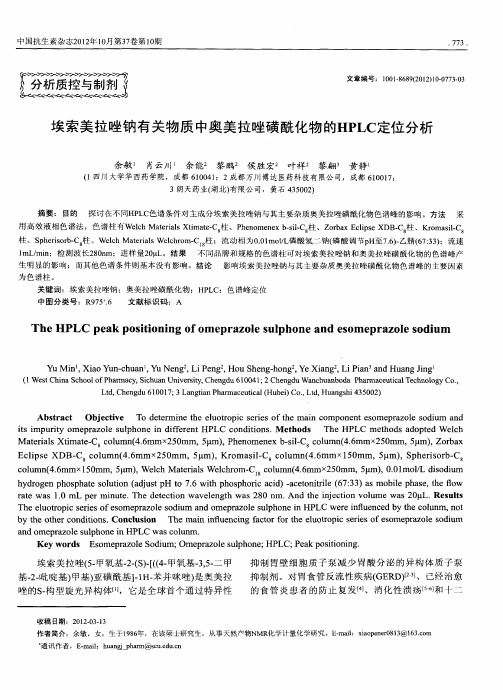
的含 量 进 行 控 制 。 目前 奥 美 拉 唑磺 酰 化 物 的含 量 测 定方 法 通 常 采 用 准 确 可 靠 、灵 敏度 高 、专 属 性 强 的
约 l ,精 密 称 定 ,置 于 1 rL 量瓶 中 ,用 流动 相 mg O 容 a 溶 解至 刻度 ,摇 匀 ,即得对 照 品溶 液 。
中国抗 生素杂志2 1年 1 月第3 卷 第1 期 02 0 7 0
73 7
文 章 编 号 : 10 .6 92 1 )00 7 3 0 18 8 (0 21—7 30
埃索美 拉唑钠 有关物质 中奥 美拉唑磺 酰化物 的HP C定位 分析 L
余敏 肖- ) X l 余 能: 黎鹏z 侯 胜宏 z 叶祥2 黎 翩3 黄静 - I -
的测 定 ,特别 需要 对 其主 要 杂质 奥美 拉 唑磺酰 化物 [ 】
供试 品溶 液 。
1 . 对 照 品溶液 制备 .2 2 取 奥美 拉 唑( 索 美 拉 唑钠 化 学结 构 与 奥美 拉 唑 埃 相 似 ,在 反相 色 谱 柱 上 的色 谱 行 为相 同 ;故 通 常 采
埃 索美 拉 唑(. 5 甲氧 基一-S一 (一 2()[ 4 甲氧 基一,一 甲 ( 35二
基 一一 啶 基) 2吡 甲基) 亚磺 酰 基]1 苯 并咪 唑) 奥美 拉 一H一 是
抑 制 胃壁 细胞 质 子泵 减 少 胃酸 分 泌 的 异 构 体质 子 泵
抑制 剂 。对 胃食管 反 流性 疾病( R c1 已经 治 愈 GE D)~、 2
b h t e o d t n . n l so T e ma n if e cn a t rf rt e eu to i e i so s me r z l s du y t e o h r c n i o s Co c u i n i h i l n i g f co o h l o r p c s re fe o p a o e o i m n u
HPLC法测定原料药中埃索美拉唑的含量
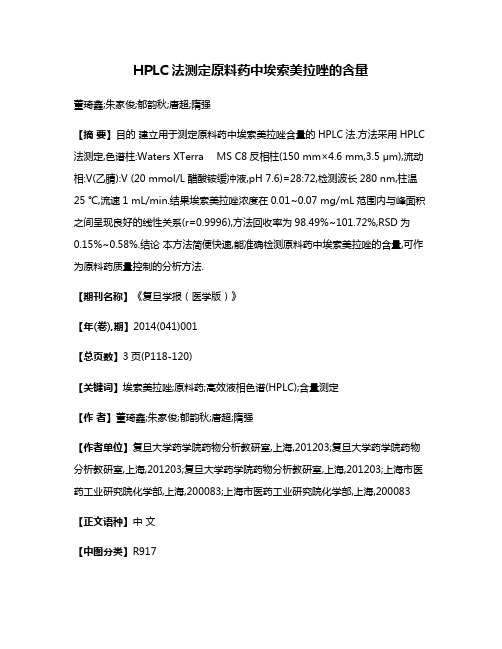
HPLC法测定原料药中埃索美拉唑的含量董琦鑫;朱家俊;郁韵秋;唐超;隋强【摘要】目的建立用于测定原料药中埃索美拉唑含量的HPLC法.方法采用HPLC 法测定,色谱柱:Waters XTerra MS C8反相柱(150 mm×4.6 mm,3.5 μm),流动相:V(乙腈):V (20 mmol/L醋酸铵缓冲液,pH 7.6)=28:72,检测波长280 nm,柱温25 ℃,流速1 mL/min.结果埃索美拉唑浓度在0.01~0.07 mg/mL范围内与峰面积之间呈现良好的线性关系(r=0.9996),方法回收率为98.49%~101.72%,RSD为0.15%~0.58%.结论本方法简便快速,能准确检测原料药中埃索美拉唑的含量,可作为原料药质量控制的分析方法.【期刊名称】《复旦学报(医学版)》【年(卷),期】2014(041)001【总页数】3页(P118-120)【关键词】埃索美拉唑;原料药;高效液相色谱(HPLC);含量测定【作者】董琦鑫;朱家俊;郁韵秋;唐超;隋强【作者单位】复旦大学药学院药物分析教研室,上海,201203;复旦大学药学院药物分析教研室,上海,201203;复旦大学药学院药物分析教研室,上海,201203;上海市医药工业研究院化学部,上海,200083;上海市医药工业研究院化学部,上海,200083【正文语种】中文【中图分类】R917埃索美拉唑是奥美拉唑的纯左旋异构体[1],化学名为5-甲氧基-2-{(S)-[(4-甲氧基-3,5-二甲基-2-吡啶基)甲基]亚硫酰基}-1 H-苯并咪唑。
它是第一种被发现的光学异构体质子泵抑制剂,与其他质子泵抑制剂一样,埃索美拉唑通过抑制胃壁细胞的H+/K+-ATP酶来降低胃酸分泌,防止胃酸形成[2]。
由于代谢方面的优势,埃索美拉唑有良好的临床疗效和可预测性,其在AUC值、生物利用度及药代动力学个体一致性方面均有一定优势,使药物到质子泵的传递增强并能提供更好的酸控制效果[3]。
离子色谱法测定奥美拉唑镁原料药中硫酸盐的含量
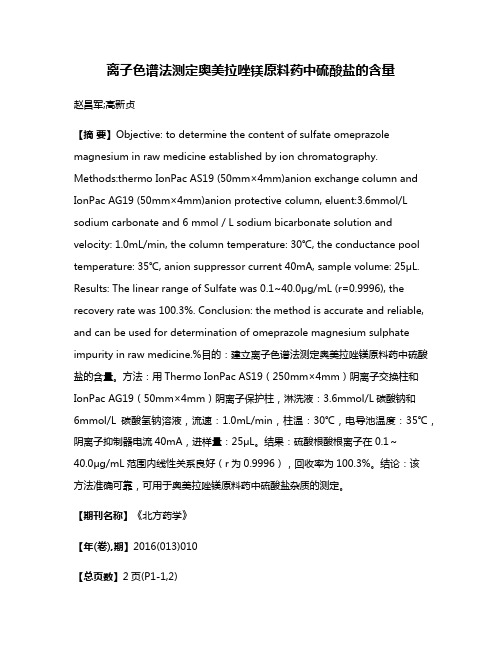
离子色谱法测定奥美拉唑镁原料药中硫酸盐的含量赵昌军;高新贞【摘要】Objective: to determine the content of sulfate omeprazole magnesium in raw medicine established by ion chromatography. Methods:thermo IonPac AS19 (50mm×4mm)anion exchange column and IonPac AG19 (50mm×4mm)anion protective column, eluent:3.6mmol/L sodium carbonate and 6 mmol / L sodium bicarbonate solution and velocity: 1.0mL/min, the column temperature: 30℃, the conductance pool temperature: 35℃, anion suppressor current 40mA, sample volume: 25μL. Results: The li near range of Sulfate was 0.1~40.0μg/mL (r=0.9996), the recovery rate was 100.3%. Conclusion: the method is accurate and reliable, and can be used for determination of omeprazole magnesium sulphate impurity in raw medicine.%目的:建立离子色谱法测定奥美拉唑镁原料药中硫酸盐的含量。
方法:用Thermo IonPac AS19(250mm×4mm)阴离子交换柱和IonPac AG19(50mm×4mm)阴离子保护柱,淋洗液:3.6mmol/L碳酸钠和6mmol/L碳酸氢钠溶液,流速:1.0mL/min,柱温:30℃,电导池温度:35℃,阴离子抑制器电流40mA,进样量:25μL。
